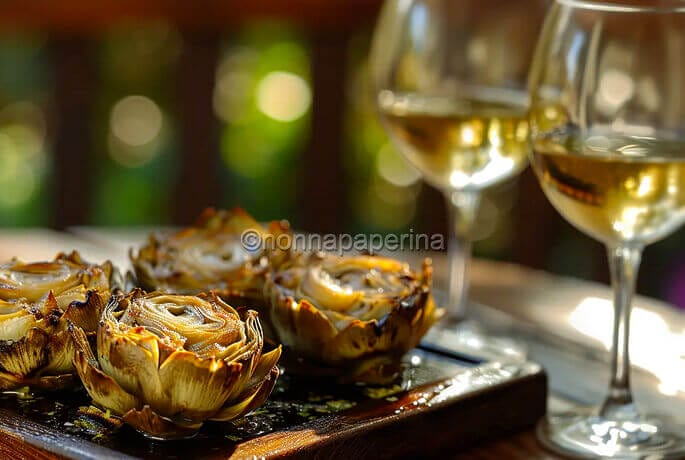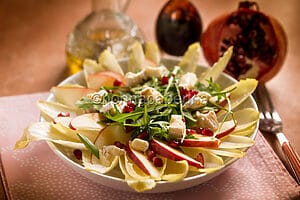
Roman-Jewish fried artichokes, a traditional Roman dish

Carciofi alla giudia: eleganza e tradizione
Roman-Jewish fried artichokes are one of the most famous dishes of Roman cuisine, loved for their crunchiness and intense flavour. But what are the origins of this delicacy? And how best can it be prepared to obtain a perfect result? In this article, we will explore the history and curiosities of this dish; we will discover how to choose the right artichokes for the recipe; we will follow the preparation step by step; and we will share the secrets for obtaining a crunchy core and a tender leaf. Finally, we will see how Roman-Jewish fried artichokes are the ideal dish to enjoy in company, perhaps accompanied by a glass of fresh white wine.

It is precisely the artichoke on the main page of the January journal, under the “Herbs and Flowers” column, which I keep with my friends Miria Onesta from ‘Due Amiche in Cucina’, Daniela Boscariolo from ‘Timo e Lenticchie’, Marialuisa Maruzzella from ‘Mantra Bio’, Elisa di Rienzo from ‘Il Fior di Cappero’, and Paola Segattini from ‘Le mie Ricette Con e Senza’. A column that aims to enhance aromatic herbs and edible flowers, highlighting the role they can play in the kitchen and their great versatility.
With recipes like the Roman-Jewish fried artichokes, this group promotes the idea of a cuisine that combines flavour and inventiveness. Together, their ideas and passions represent a synergy to which each writer brings their own distinct perspective, improving the column and providing readers with a varied and engaging gastronomic experience.
Recipe Roman-Jewish fried artichokes
Preparation Roman-Jewish fried artichokes
To prepare the Roman-Jewish fried artichokes, follow these steps:
- Remove the tough outer leaves of the artichokes and cut off the thorny tips. Leave only the tender core and the soft inner leaves. Do the same with the stem, eliminating the hardest part.
- Immerse the artichokes in water with lemon for about 10 minutes to prevent them from blackening. Drain them well and pat them dry on a paper towel.
- In a large pan, heat lots of oil. Dip the artichokes upside down, applying light pressure to the bottom of the pan, and fry until they become golden and crispy. It will take approximately 12 minutes. For the artichokes to be both tender on the inside and crispy on the exterior, the oil must be extremely hot.
- Drain the artichokes on a paper towel, and once cooled, gently open the leaves with your hands, making them resemble a flower.
- Always dip the artichokes upside down into the boiling oil a second time for about 2-3 minutes.
- Drain the artichokes on absorbent paper, cut off the excess stem, and sprinkle them with coarse salt.
Ingredients Roman-Jewish fried artichokes
- 4 Roman artichokes
- lemon juice from a whole lemon
- frying oil
- coarse salt (to taste)
Origins and curiosities of Roman-Jewish fried artichokes
Roman-Jewish fried artichokes are one of the most famous and delicious dishes in Roman cuisine. Their origin dates back to the 16th century, when the Jewish community of Rome prepared artichokes in this way for the Jewish Easter celebration. The name “alla giudia (from the Italian name Carciofi alla Giudia)” derives precisely from this culinary tradition.
The peculiarity of this recipe lies in the fact that the artichokes are fried whole, with the stem facing upwards, until they are crispy on the outside and tender on the inside.
Curiously, Roman-Jewish fried artichokes were not initially a dish much appreciated by the Romans but were only re-evaluated in the twentieth century thanks to the interest of foreign tourists. Today, the Roman-Jewish fried artichokes have become a symbol of Roman cuisine and are appreciated throughout the world for their unique flavour and fascinating history.
How to choose the right artichokes for the recipe
To prepare Roman-Jewish fried artichokes, it is essential to choose the right artichokes. To do this, it is important to consider some factors. First of all, it is necessary to choose fresh artichokes, i.e., those with turgid and compact leaves. Furthermore, it is advisable to choose smaller artichokes, as those that are too large could be hard and fibrous. Another aspect to consider is the shape of the artichoke. For this recipe, it is better to opt for heart-shaped ones, as they have a more delicate flavour than other types of artichokes. Finally, before buying artichokes, it is a good idea to check that they do not have dark spots or soft parts, which could indicate poor quality. By following these tips, it will be possible to obtain perfect artichokes for the Roman-Jewish fried artichokes recipe.

How to make Roman-Jewish fried artichokes step-by-step
There are a few basic steps that must be followed in order to prepare the Roman-Jewish fried artichokes. The artichokes must first be thoroughly cleaned by removing the tip and the toughest outer leaves. The stem then needs to be sliced so that only a few centimetres remain. To keep the artichokes from oxidising, they should be cleaned and then submerged in water with a lemon. After that, we proceed with the cooking: the artichokes should be fried in boiling oil at a temperature of around 170-180 degrees Celsius. While frying, it is important to keep the artichokes pressed down with a lid or wooden spoon to prevent them from floating excessively. Once golden, the Roman-Jewish fried artichokes should be drained and dried on absorbent paper to eliminate excess oil. Finally, the artichokes can be served hot or cold, accompanied by a sprinkling of coarse salt and fresh lemon juice.
The secrets to obtaining a crunchy core and tender leaves
To obtain a crunchy core and tender leaves in Roman-Jewish fried artichokes, there are some secrets to take into consideration. First of all, it is important to choose the right artichokes, i.e., fresh and still closed ones, with compact leaves and a beautiful, intense green colour. Moreover, you can soak the artichokes in water and lemon for a few minutes before cooking to avoid them being very bitter. During cooking, it is important to completely immerse the artichokes in the hot oil and keep the temperature constant. Once fried, the artichokes must be drained on absorbent paper to eliminate excess oil. Finally, to get the most out of the Giudia artichoke recipe, it is advisable to serve them immediately after cooking, accompanied by a good glass of white wine and in the company of friends and family.
Roman-Jewish fried artichokes FAQs
When is the best season to enjoy Roman-Jewish fried artichokes?
The best season to enjoy Giudia artichokes is generally during the spring, particularly from March to May.
What are the best artichokes for Roman-Jewish fried artichokes?
In general, Roman artichokes are often considered the best for preparing Roman-Jewish fried artichokes, but you can look for local varieties or those available in your region. The choice of high-quality artichokes is essential to obtaining the best result in this traditional Roman dish.
Do we have recipes with artichokes? Of course we do!
COULD IT BE INTERESTING FOR YOU

Cardoons with Parmesan, an easy and tasty dish...
What to know about cardoons The most unique component of this Parmigiana are the cardoons, so it's helpful to go deeper into the subject. Due to their rustic flavour, cardoons are a highly excellent...

Camembert and apple salad, a sweet and savoury...
A focus on Camembert The Camembert cheese is the primary component of this salad. This is no ordinary white rind cheese; its "delicate flavour" brings out the sweetness of fresh fruit and the body...


















